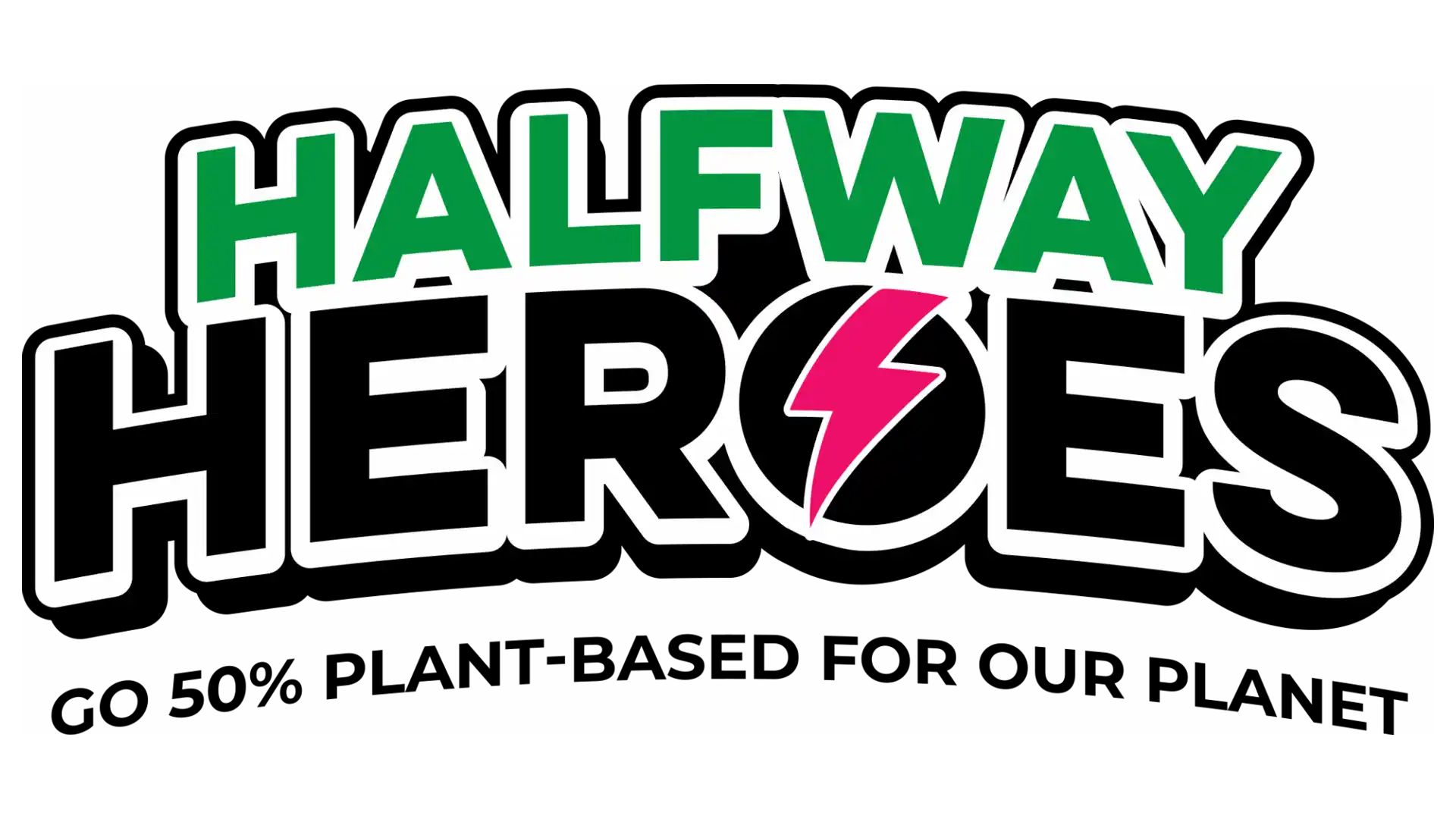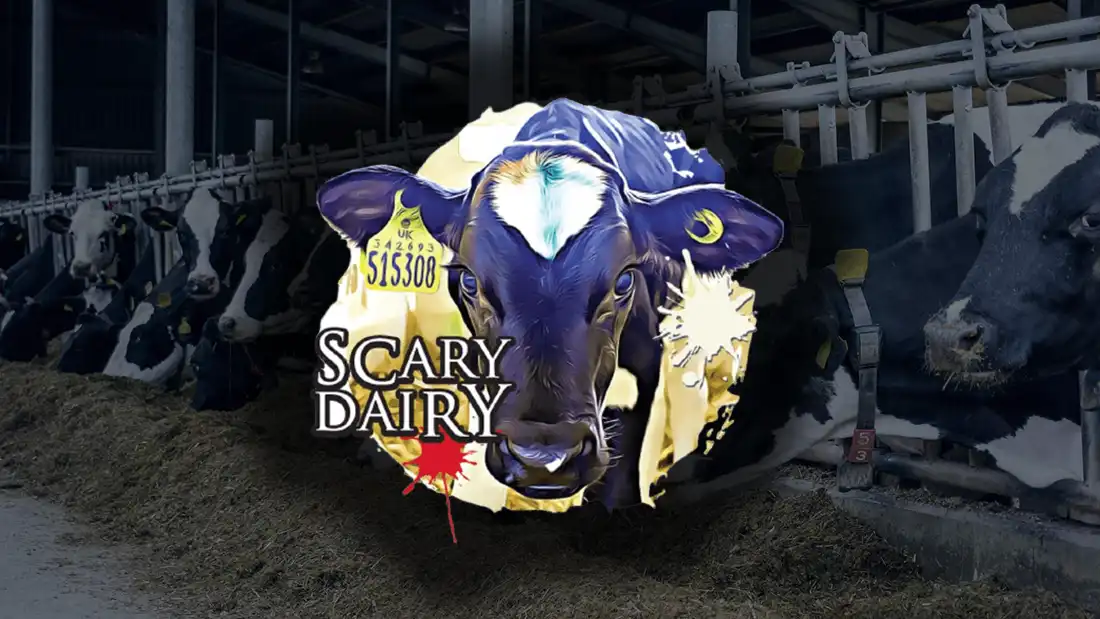Prawns and Shrimp
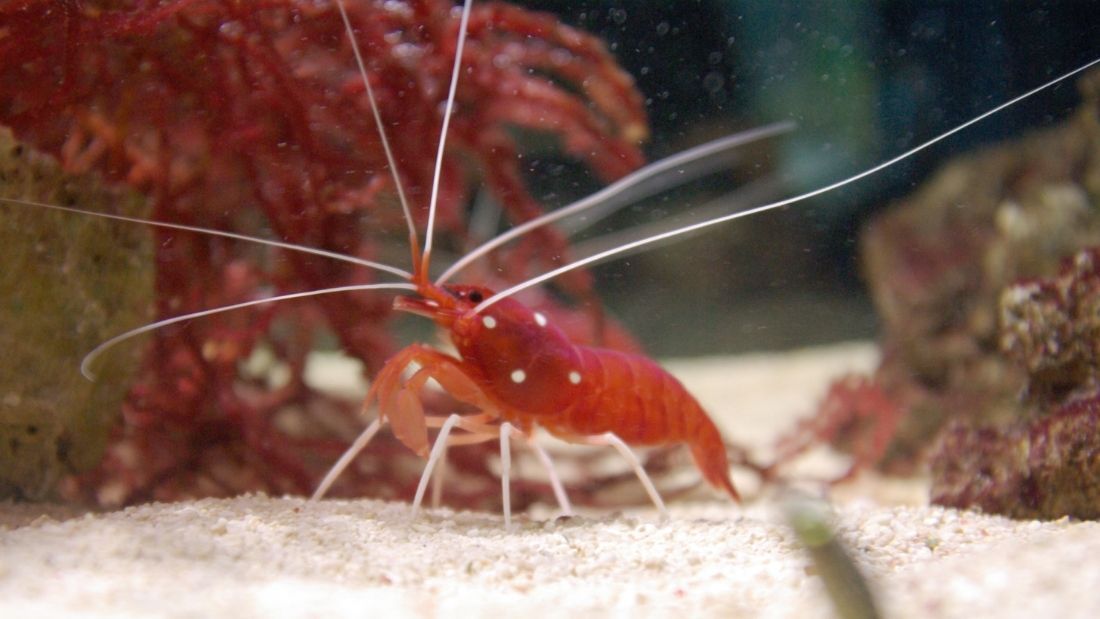
- The Pistol prawn competes with the sperm whale as the noisiest animal of the ocean, even though the little creature is smaller than your finger. Its home-grown ‘gun’ creates pressurised bubbles that fire out at speeds of 100kmh, creating a noise as loud as an exploding grenade which reaches a temperature equal to the sun’s surface! So powerful is it that it immediately stuns or kills the prawn’s prey.5Riley, A., 2016, ‘This shrimp is carrying a real-life working stun gun.’ BBC, 29 January. Available at http://www.bbc.co.uk/earth/story/20160129-the-shrimp-that-has-turned-bubbles-into-a-lethal-weapon [Accessed 7 September 2020].
- Certain prawns, like the Spot prawn, are able to camouflage themselves by changing colour to blend in with their environment. Others, like the Ghost shrimp, are transparent and almost invisible within their surroundings.
- Some prawn species can change sex, but the Peppermint shrimp goes one step further. All mature as males and then turn into hermaphrodites (developing both male and female sex organs) if and when needed, based on the size of their social group.6Marshall, M., 2010. ‘Zoologger: Shrimp plays chicken with its sex change.’ New Scientist, 8 September. Available at https://www.newscientist.com/article/dn19419-zoologger-shrimp-plays-chicken-with-its-sex-change/ [Accessed 7 September 2020].
- Cleaner shrimp have found an innovative way of getting their next meal. They dance around in a stylised way to attract fish to them and having done so, they jump into the open mouths of fish and clean them up, eating bloodsucking parasites as part of a symbiotic relationship.7Giaimo, C., 2019. ‘It’s a Dirty Job, but Someone Has to Do It and Not Get Eaten.’ New York Times, 19 September. Available at https://www.nytimes.com/2019/09/19/science/cleaner-shrimp.html [Accessed 7 September 2020].
- There are over 2,000 species of shrimp and prawns; some of them are so small you can barely see them with the naked eye while others stretch to over eight inches. Some species thrive in icy Arctic waters, others in tropical waters, and you’ll find them all over the world, from lakes and rivers to coastlines and estuaries.8Tikkanen, A., 2020. ‘Shrimp.’ Britannica, 4 March. Available at https://www.britannica.com/animal/shrimp-crustacean [Accessed 7 September 2020]
Do Prawns and Shrimp Feel Pain?
Prawns and shrimp, along with other crustaceans such as crabs and lobsters, are not covered under any welfare protection laws in the UK.15Animal Welfare Act 2006. Available at https://www.legislation.gov.uk/ukpga/2006/45/section/1 [Accessed 7 September 2020]. The Animal Welfare Act 2006 does not even consider them as animals, meaning that they can be caught, trapped and killed however a person sees fit.
However, studies have repeatedly shown that marine animals such as fish, lobsters, prawns and shrimp do, of course, feel pain.16Diarte-Plata, G., Sainz-Hernandez, J., Aguinage-Cruz, J., Fierro-Coronado, J., Polanco-Torres, A., Puente-Palazeulos, C., 2012. ‘Eyestalk ablation procedures to minimize pain in the freshwater prawn Macrobrachium americanum.’ Applied Animal Behaviour Science, September. Vol. 140. Available at https://www.sciencedirect.com/science/article/abs/pii/S0168159112001761 [Accessed 7 September 2020]. In one horrible study, Glass prawns reacted to a noxious substance applied to their antennae by grooming the antennae extensively, showing that they were affected by the substance. When a local anaesthetic was applied and the pain was removed, they stopped grooming the antennae so obsessively, a clear indication that they were no longer feeling the pain-inducing substance.17Barr, S., R. Laming, P., T.A. Dick, J., W. Elwood, R., 2008. ‘Nociception or pain in a decapod crustacean?’ Animal Behaviour, 3 March. 75, (3). Available at https://www.sciencedirect.com/science/article/abs/pii/S0003347207004332 [Accessed 8 September 2020].
Professor Robert Elwood has dedicated much of his career to establishing whether crustaceans experience pain and, after decades of research, now urges the world to rethink their treatment of these fascinating animals. As Professor Elwood says, it makes complete evolutionary sense for prawns and shrimp to feel pain, just like dogs, cats, pigs or humans.18Derbyshire, D., 2007. ‘Prawns do feel pain, say scientists.’ Daily Mail, 8 November. Available at https://www.dailymail.co.uk/sciencetech/article-492323/Prawns-feel-pain-say-scientists.html [Accessed 7 September 2020]. Experiencing pain is part of an animal survival mechanism where they learn to avoid potentially damaging experiences in the future. It’s much the same as a human burning their hand in a fire – they learn not to do it again.
Some people claim that prawns and shrimp don’t feel pain because they don’t have the same nervous system as humans. Professor Elwood dismisses that and says that to deny an animal the ability to ‘feel pain because they don’t have the same biology [as us] is like denying they can see because they don’t have a visual cortex’.19Stelling, T., 2014. ‘Do lobsters and other invertebrates feel pain? New research has some answers.’ The Washington Post, March 10. Available at https://www.washingtonpost.com/national/health-science/do-lobsters-and-other-invertebrates-feel-pain-new-research-has-some-answers/2014/03/07/f026ea9e-9e59-11e3-b8d8-94577ff66b28_story.html [Accessed 7 September 2020]. Some animals have different ways of seeing than humans but it’s obvious that they still have the ability to see. It follows that we can’t assume that other animals don’t feel pain just because they don’t have exactly the same biological structure as us.
The European Food Safety Authority – an independent body that bases its conclusions on scientific research – has for over 15 years been calling for prawns and shrimp to be placed in the same category as animals we already agree feel pain, such as chickens, pigs and sheep.20European Food Safety Authority, 2005. ‘Opinion on the “Aspects of the biology and welfare of animals used for experimental and other scientific purposes.”’ Available at https://efsa.onlinelibrary.wiley.com/doi/abs/10.2903/j.efsa.2005.292 [Accessed 8 September 2020]. It really is time that the government took action to minimise the pain and suffering inflicted on the millions of prawns and shrimp killed and eaten each year in the UK.
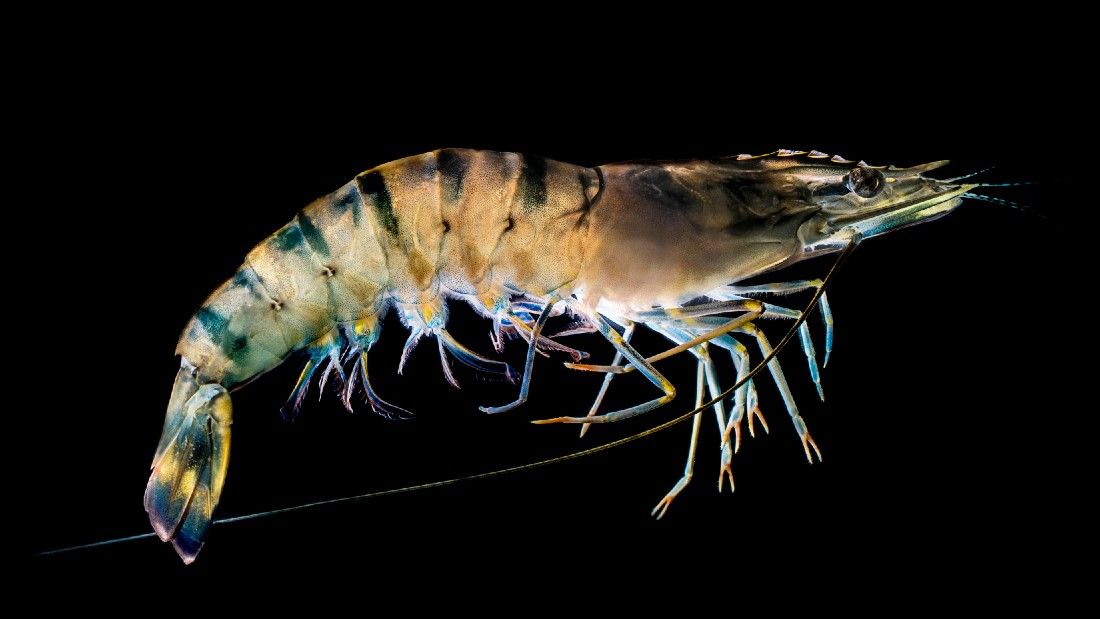
What’s the difference between prawns and shrimp?
The two terms, prawn and shrimp, are often used interchangeably. In the UK, we tend to use the word ‘prawn’ to refer to both prawns and shrimp while the USA does the opposite. It’s easy to see why the terms are mixed up – they are both decapods, meaning that they have ten legs, and at a glance they look extremely similar. Some people associate the word ‘shrimp’ with smallness, but some types of shrimp are bigger than some types of prawn, adding to the confusion.
The main difference is in their body form, with shrimp more able to bend their bodies because their three segments (head, abdomen, and thorax) don’t overlap each other in the way that prawns’ do. Prawns also have three pairs of claw-like legs, while shrimp have just the one. They also have different ways of rearing their young; prawns simply release their eggs into the water to let them grow on their own, while shrimp carry their fertilized eggs (up to 14,000 of them!) on their bodies.4Tikkanen, A., 2020. ‘Shrimp.’ Britannica, 4 March. Available at https://www.britannica.com/animal/shrimp-crustacean [Accessed 7 September 2020] Shrimp are more closely related to lobsters, crabs, and crayfish than prawns are.
Despite the differences, both shrimp and prawns suffer in the same way at the hands of humans in terms of how they are caught, killed and cooked.
Prawns have evolved over hundreds of millions of years and there are now more than 2,000 species.4Tikkanen, A., 2020. ‘Shrimp.’ Britannica, 4 March. Available at https://www.britannica.com/animal/shrimp-crustacean [Accessed 7 September 2020] They vary so much that it’s impossible to detail how all their natural lives differ, but we can give you a sense of how these fascinating animals live when free of human interference.
Where Did They Come From?
One species of shrimp claims the title of the world’s oldest living animal.27The Telegraph, 2010. ‘Shrimp “is world’s oldest surviving animal.”’ The Telegraph, 29 July. Available at https://www.telegraph.co.uk/news/earth/wildlife/7916880/Shrimp-is-worlds-oldest-surviving-animal.html [Accessed 7 September 2020] Found in Britain, the Tadpole shrimp is almost exactly the same today as it was 200 million years ago. Decapods, including shrimp, prawns, lobsters and crabs have a long family tree, stretching over 500 million years.28Tejedor, C., 2019. ‘Crabs, lobsters and shrimp now have a family tree dating 500 million years.’ Phys.org, 24 April. Available at https://phys.org/news/2019-04-crabs-lobsters-shrimp-family-tree.html [Accessed 7 September 2020].
Natural Diet
Prawns’ diets vary depending on the species and their habitat. Most will eat plant matter such as algae and often scavenge the dead remains of fish, crabs, snails, worms and anything else they can find on the ocean floor.29Department of Primary Industries and Regional Development, 2013. ‘Prawn.’ Department of Primary Industries and Regional Development, 9 April. Available at http://www.fish.wa.gov.au/species/prawn/Pages/default.aspx#:~:text=Prawns%20can%20live%20for%20two,once%20in%20any%20one%20year [Accessed 7 September 2020]. Some prawns, like the Pistol prawn, actively hunt for animals such as crabs, using their incredible ‘pistol claw’ to stun or kill them with a burst of power.1Riley, A., 2016, ‘This shrimp is carrying a real-life working stun gun.’ BBC, 29 January. Available at http://www.bbc.co.uk/earth/story/20160129-the-shrimp-that-has-turned-bubbles-into-a-lethal-weapon [Accessed 7 September 2020]. Cleaner shrimp eat the dead skin or parasites that feed on fish in a mutually beneficial relationship, giving the shrimp a meal and the fish a much-needed cleanse from parasites.3Giaimo, C., 2019. ‘It’s a Dirty Job, but Someone Has to Do It and Not Get Eaten.’ New York Times, 19 September. Available at https://www.nytimes.com/2019/09/19/science/cleaner-shrimp.html [Accessed 7 September 2020].
Life Expectancy
Life expectancy depends on the type of prawn or shrimp but most shrimp live from one to seven years, while most prawns live for two to three years (Department of Primary Industries and Regional Development, 2013). In aquaculture farms, they are killed at 100 days old, a fraction of their natural life expectancy.30Bermudez-Almada, M.C.., Espinosa-Plascencia, A., 2012. ‘The Use of Antibiotics in Shrimp Farming.’ Research Center for Food and Development, April. Available at https://cdn.intechopen.com/pdfs/35142/…of_antibiotics_in_shrimp_farming.pdf [Accessed 8 September 2020].
Predators
Because prawns live in so many different habitats – freshwater lakes, rivers and seas – there is a wide range of animals who prey on them. They include cuttlefish, bottom-dwelling fish, squid, various birds, including flamingos, octopi and, of course, humans.
Wild Capture and Aquaculture
Prawn wild fisheries are being exploited to their maximum capacity and beyond all across the world.31Gilett, R., 2008. ‘Global study of shrimp fisheries.’ Food and Agriculture Organization of the United Nations. Available at http://www.fao.org/3/i0300e/i0300e00.pdf [Accessed 7 September 2020]. Instead of accepting that we must significantly reduce or end this unsustainable exploitation of marine creatures, governments have instead ramped up prawn and shrimp production through intensive farming – aquaculture. Producing 4.4 million tonnes annually, aquaculture now outstrips wild-caught shrimp and prawns which totals 3.6 million tonnes.32FAO, 2018. ‘Fishery and Aquaculture Statistics.’ FAO, 31 December. Available at http://www.fao.org/3/ca5495t/CA5495T.pdf [Accessed 7 September 2020].
Size of the Prawn and Shrimp Industry
In 2018, UK consumers bought almost 40,000 tonnes of prawns and shrimp, with a retail value of £526 million.37Pegg, S., 2019. ‘Market Insight Factsheet: Prawn and Shrimp.’ Seafish, March. Available at https://www.seafish.org/document/?id=14501ed6-60d1-4d6e-b630-da2d96c50908 [Accessed 7 September 2020]. Almost all prawn and shrimp consumed in the UK is imported, with the majority coming from India.17Pegg, S., 2019. ‘Market Insight Factsheet: Prawn and Shrimp.’ Seafish, March. Available at https://www.seafish.org/document/?id=14501ed6-60d1-4d6e-b630-da2d96c50908 [Accessed 7 September 2020]. In 2017, 22 per cent of the total value of marine imports came from prawns and shrimp.17Pegg, S., 2019. ‘Market Insight Factsheet: Prawn and Shrimp.’ Seafish, March. Available at https://www.seafish.org/document/?id=14501ed6-60d1-4d6e-b630-da2d96c50908 [Accessed 7 September 2020].
0.1 per cent of the total tonnage of species landed by UK vessels were prawns and shrimp, which still equates to millions of prawns and shrimp every year.17Pegg, S., 2019. ‘Market Insight Factsheet: Prawn and Shrimp.’ Seafish, March. Available at https://www.seafish.org/document/?id=14501ed6-60d1-4d6e-b630-da2d96c50908 [Accessed 7 September 2020]. With marine capture, the number of animals slaughtered and eaten is so large that they are only counted in terms of how many tonnes are caught, not by individual numbers.
Although there are thousands of types of prawns and shrimp, the warm-water Tiger and King prawns and the cold-water North Atlantic prawns are the most commonly sold in the UK. Most cold-water prawns and shrimp are wild-captured while warm-water prawns and shrimp are typically farmed. There is also the Common prawn, which is found around the coastlines of England and Wales and is commercially farmed as well as used by anglers as bait. But most consumed prawns and shrimp in the UK are warm-water Tiger and King prawns imported from industrial farms in Asia, mostly from Thailand, Vietnam, India, Indonesia and Bangladesh.38Davies, R., 2016. ‘Wild-caught tropical shrimp imports into the EU and associated impacts on marine turtle populations: the need for EU import restrictions.’ CRPMEM. Available at http://nebula.wsimg.com/b0a5ed50c755e38c916c7fc6f86fad8f?AccessKeyId=3C48B2CCA490ABB8A09E&disposition=0&alloworigin=1 [Accessed 19 January 2021]. The most farmed crustacean in the world is the King prawn, which is one of the most consumed prawns in the UK and mostly is imported from South-East Asia.39Fletcher, R., 2019. ‘Britain’s prawn farming pioneers.’ The Fish Site, June. Available at https://thefishsite.com/articles/britains-prawn-farming-pioneers [Accessed 19 January 2021].
How Prawns and Shrimp are Captured
There are two types of commercial prawn and shrimp production. Capture fishing means wild species are caught from oceans, rivers, seas and lakes, usually by bottom trawlers, while aquaculture farms prawns and shrimp in controlled conditions. Now that wild fisheries are at maximum or above maximum capacity, the world is increasing production from aquaculture, which is basically just another form of factory farming to continue our unsustainable demand for these animals’ flesh, regardless of its cost to the animals or the environment.
Our insatiable demand for marine species has plundered the oceans, and so we turn to aquaculture. But aquaculture farms continue to strip bear the ocean by capturing fish to feed to the animals they farm! Neither capture fishing nor aquaculture is in any way sustainable when our oceans are so stretched already.
Capture Fishing
Wild-Capture Trawling
Bottom trawling means that a weighted net is dragged along the seabed, capturing animals who are in the net’s path, before the net is pulled up to the boat. It is an incredibly damaging industrial method of capturing marine animals. The weighted net scrapes along the ocean floor and destroys everything in its path, such as coral reefs, other habitats and breeding populations. Coral reefs, crucial ecosystems for all kinds of animals that have thrived for hundreds of years, are destroyed in a matter of seconds.
As prawns and shrimp are some of the smallest marine animals, trawlers use very fine-mesh nets to be able to capture them. This has a huge ethical and environmental cost. Because most marine life is of the same size or bigger than a prawn, it means that these fine-mesh nets capture almost every single marine animal as they are dragged along the sea floors. As a consequence, prawn and shrimp trawlers are one of the most destructive forms of fishing in the world.40Clucas, I., 1997. ‘A Study of the Options for Utilization of Bycatch and Discards from Marine Capture Fisheries.’ Food and Agriculture Organization of the United Nations. Available at http://www.fao.org/3/W6602E/w6602E09.htm [Accessed 8 September 2020].

Once the net is full of trapped animals, wild-capture trawlers will then pull the net up to the surface, store the prawns and shrimp on the boat in ice-controlled holds, and discard all other animals who are considered as nothing more than ‘bycatch’. Once the boat returns to land, prawns and shrimp will then be frozen to death and exported to the UK for consumption. By far the most common way for these animals to be sold in the UK is as frozen products.
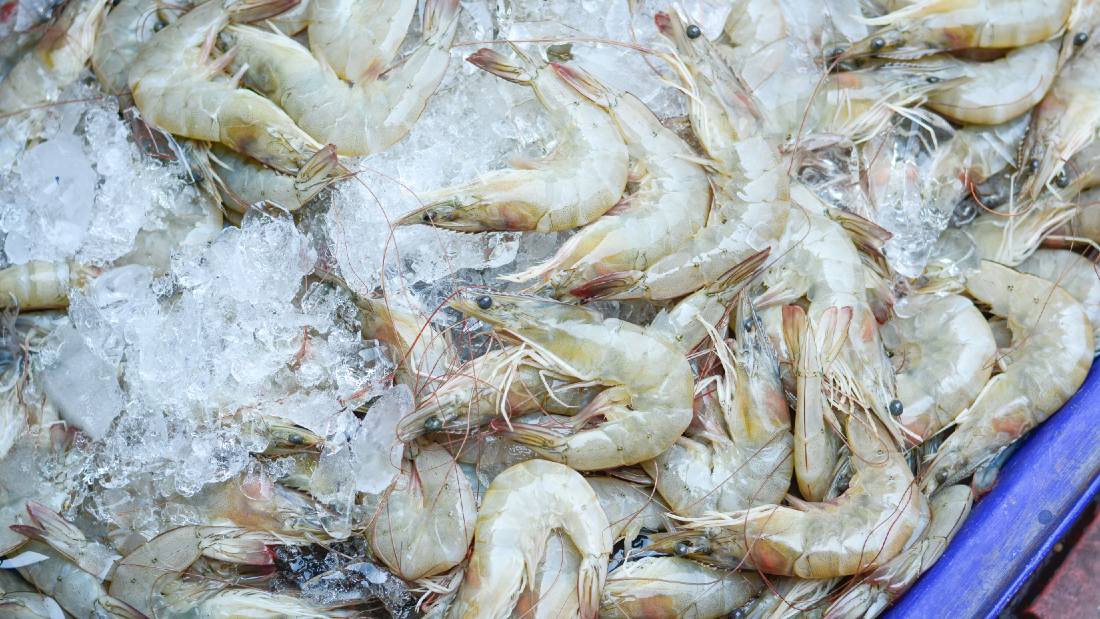
Bycatch
Bycatch means animals who are caught in a boat’s nets or hooks who are not the targeted animal, in this case meaning any animal who isn’t a prawn or a shrimp. Prawn and shrimp boats have the highest rate of discarded bycatch in the entire fishing industry.20Clucas, I., 1997. ‘A Study of the Options for Utilization of Bycatch and Discards from Marine Capture Fisheries.’ Food and Agriculture Organization of the United Nations. Available at http://www.fao.org/3/W6602E/w6602E09.htm [Accessed 8 September 2020]. Prawn and shrimp trawlers pose the biggest threat to seahorse populations and 150,000 turtles are killed by trawlers annually.43Kirby, A., 2003. ‘Prawn fishing “plundering seas.”’ BBC, 19 February. Available at http://news.bbc.co.uk/1/hi/sci/tech/2776359.stm [Accessed 8 September 2020]. Other animals, including sea snakes, dolphins and sharks and so many more, are thrown back into the ocean, often dead, dying or severely injured.
It is incredibly difficult to estimate how many animals are killed per year from bycatch, but it is predicted to be somewhere in the region of 40 per cent of total global catch of all marine animals, a staggering 63 billion pounds of animals which equates to trillions of animals carelessly caught, fatally injured or killed and then discarded back into the oceans.44Keledjian, A., Brogan, G., Lowell, B., Warrenchuk, J., Enticknap, B., Shester, G., Hirshfield, M., Cano-Stocco, D., 2014. ‘Wasted Catch.’ Oceana, March. Available at https://oceana.org/sites/default/files/reports/Bycatch_Report_FINAL.pdf [Accessed 20 January 2021]. It’s estimated that as many as 650,000 whales, seals and dolphins were killed every single year from bycatch throughout the 1990s and the prawn and shrimp industries are the worst culprits.22Keledjian, A., Brogan, G., Lowell, B., Warrenchuk, J., Enticknap, B., Shester, G., Hirshfield, M., Cano-Stocco, D., 2014. ‘Wasted Catch.’ Oceana, March. Available at https://oceana.org/sites/default/files/reports/Bycatch_Report_FINAL.pdf [Accessed 20 January 2021].20Clucas, I., 1997. ‘A Study of the Options for Utilization of Bycatch and Discards from Marine Capture Fisheries.’ Food and Agriculture Organization of the United Nations. Available at http://www.fao.org/3/W6602E/w6602E09.htm [Accessed 8 September 2020].
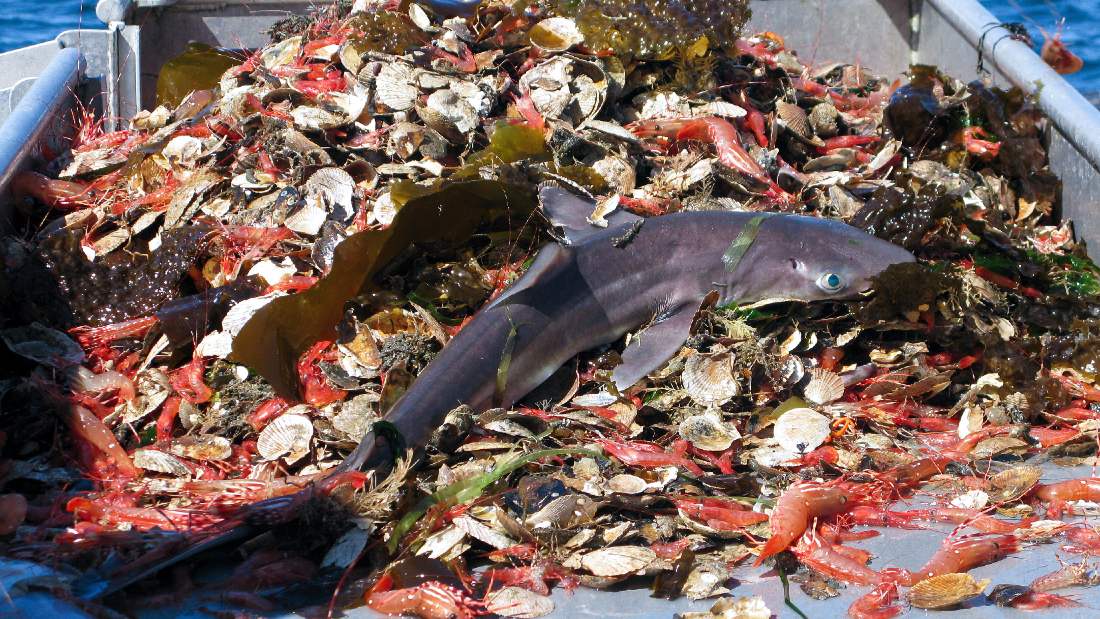
Ghost fishing
As with fishing for any other animal, the prawn and shrimp industries are directly responsible for a huge amount of ‘ghost fishing’ – fishing gear, nets and other fishing debris that is lost or discarded into the oceans and which poses serious threats to marine life. The fishing gear ends up floating through the oceans or tangled on the seabed, catching marine life in nets or hooks, who are left to starve to death or die from injuries. This ‘ghost gear’ creates a vicious cycle – animals are trapped in the gear, die, and then other animals are attracted to the site to eat the dead animals, consequently becoming trapped and dying, and so on and on.
In 2019 a report found that discarded fishing gear is the largest plastic polluter in our oceans.46Laville, S., 2019. ‘Dumped fishing gear is biggest plastic polluter in ocean, finds report.’ The Guardian, 6 November. Available at https://www.theguardian.com/environment/2019/nov/06/dumped-fishing-gear-is-biggest-plastic-polluter-in-ocean-finds-report [Accessed 19 January 2021]. Over 640,000 tonnes of fishing gear end up in our waters every single year, the equivalent to dumping 55,000 double-decker buses of plastic into oceans every year.23Laville, S., 2019. ‘Dumped fishing gear is biggest plastic polluter in ocean, finds report.’ The Guardian, 6 November. Available at https://www.theguardian.com/environment/2019/nov/06/dumped-fishing-gear-is-biggest-plastic-polluter-in-ocean-finds-report [Accessed 19 January 2021].
One of the best ways to cut down on plastic pollution is through ending our consumption of marine life. As much as 70 per cent of large plastic found floating on the surface of the ocean is related to fishing.23Laville, S., 2019. ‘Dumped fishing gear is biggest plastic polluter in ocean, finds report.’ The Guardian, 6 November. Available at https://www.theguardian.com/environment/2019/nov/06/dumped-fishing-gear-is-biggest-plastic-polluter-in-ocean-finds-report [Accessed 19 January 2021].
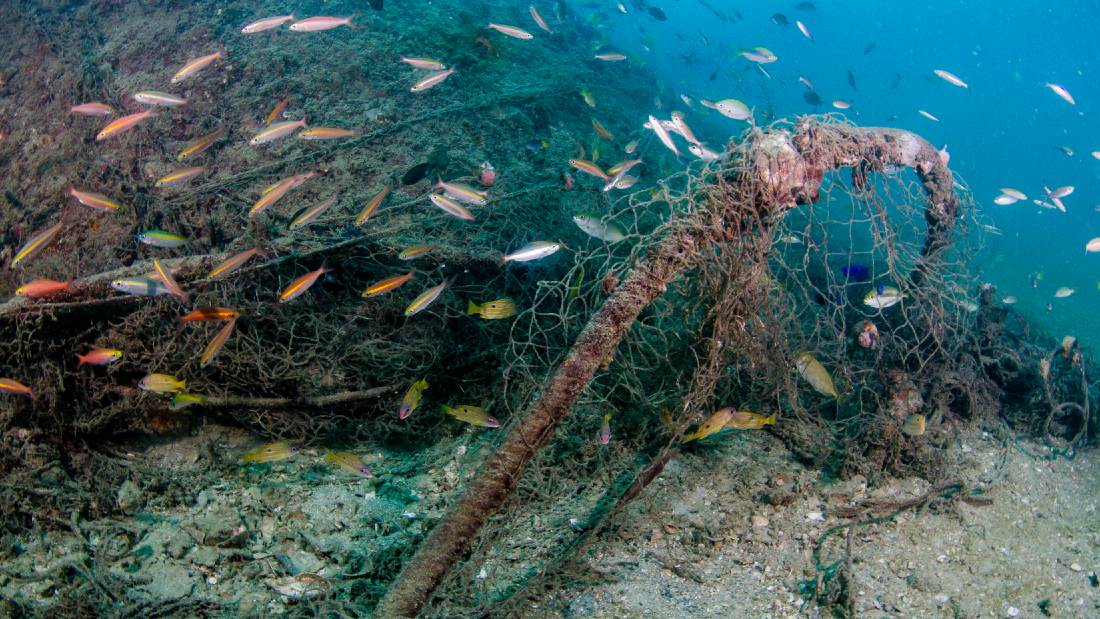
Wild Capture Potting
There is a small-scale industry in the UK of ‘potting’ prawns and shrimp, where pots are baited and left until prawns and shrimp enter the pots and are pulled to the surface. It is much the same as a lobster pot. This method forms a negligible proportion of the prawns and shrimp consumed in the UK, and in fact most prawns and shrimp caught by potting are then sold in Spain.48Cornwall Good Seafood Guide. ‘Prawns.’ Cornwall Good Seafood Guide. Available at https://www.cornwallgoodseafoodguide.org.uk/fish-guide/prawns.php [Accessed 19 January 2021].
While this system of potting has less of an impact than bottom trawling or aquaculture, it would be impossible for such a method to be used to feed the UK’s insatiable demand for prawns and shrimp. Given that the vast majority of our oceans are suffering from overfishing and prawns and shrimp form an incredibly important part of the ecosystem, it is impossible to claim that any practice which hauls out tonnes of prawns and shrimp from our overfished oceans is sustainable. And, of course, the process still involves the unnecessary taking of another animal’s life.
Aquaculture
We don’t often spare a thought for animals like prawns, but the practices inflicted on these farmed animals are gruesome, cruel and completely unregulated, with ethical issues affecting
not just animals but also the workers, many of whom suffer abhorrent conditions in a form of modern slavery. The industry is also mired in environmental destruction.
Prawn and shrimp farming has spawned all across the world in various forms, but most prawns and shrimp consumed in the UK are imported from South-East Asian farms which farm warm-water prawns, primarily Tiger, Brown and King prawns. Globally, the industry is huge and there are several different ways in which these crustaceans are farmed. Most typically, prawns and shrimp are kept in man-made, concrete, shallow ponds near or over existing mangrove forests and brackish waters but cages, irrigation ditches, reservoirs and natural waters are also used to a smaller degree.50FAO, 2002. ‘Farming freshwater prawns.’ Food and Agriculture Organisation of the United Nations. Available at http://www.fao.org/3/y4100e/y4100e08.htm#P1354_219801 [Accessed 19 January 2021]. As you can see in the below photo, individual ponds are built next to one another near brackish water to form huge swathes of land, all of which was once a thriving mangrove forest.
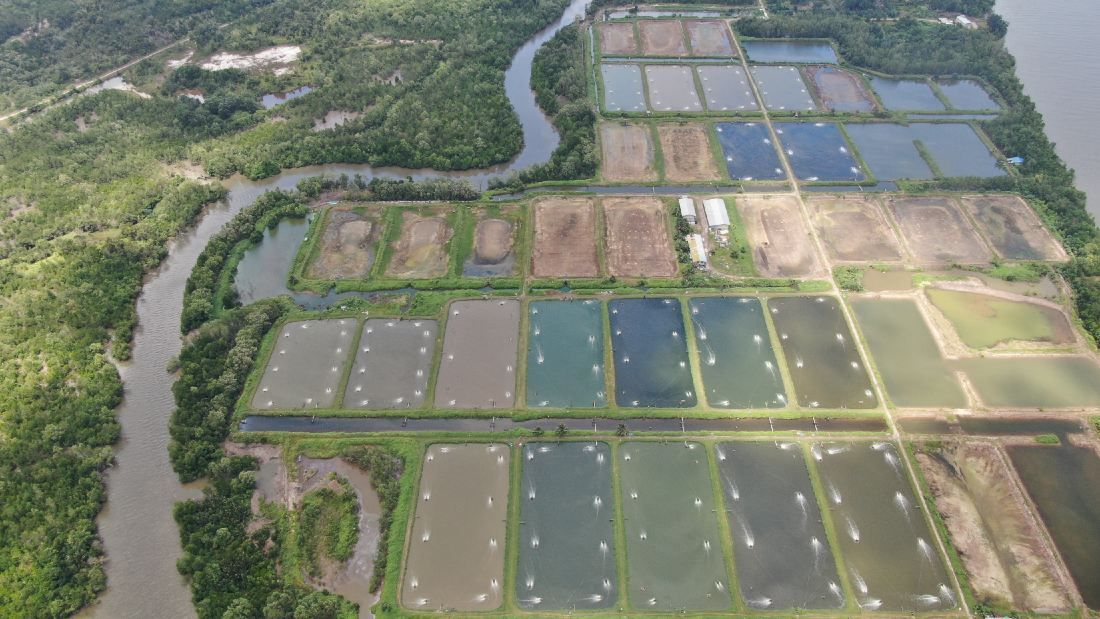
The prawn and shrimp industry is notoriously unregulated and farmers are rarely forced into following any sort of rules on stocking numbers, how large ponds can be, the maximum amount of antibiotics to be used or environmental protection. Each concrete, man-made pond can hold tens of thousands of prawns or shrimp and can hold up to 150 prawns or shrimp in just one square metre.52Parry, L., 2015. ‘How safe are the prawns YOU’RE eating? Farmed shrimp found to contain traces of E.coli, MRSA and salmonella.’ Daily Mail, April. Available at https://www.dailymail.co.uk/health/article-3053917/How-safe-prawns-eating-Farmed-shrimp-contain-traces-E-coli-MRSA-salmonella.html [Accessed 19 January 2021]. Individual ponds tend to range between 0.2 to
1.6 hectares but farms as a whole are comprised of ponds next to each other. These farms as a whole can exceed 70 hectares, the size of seven Wembley Stadiums.25FAO, 2002. ‘Farming freshwater prawns.’ Food and Agriculture Organisation of the United Nations. Available at http://www.fao.org/3/y4100e/y4100e08.htm#P1354_219801 [Accessed 19 January 2021].
The Life of a Farmed Prawn or Shrimp
Intensive Farming
Intensive farming produces the highest number of prawns or shrimp per hectare and is as far removed from a prawn’s natural life as possible. Larvae are born into ‘hatcheries’ or ‘nurseries’ – small concrete ponds – for the first two weeks of life and then moved to ‘growout’ farms where they are kept for four to five months and then harvested.
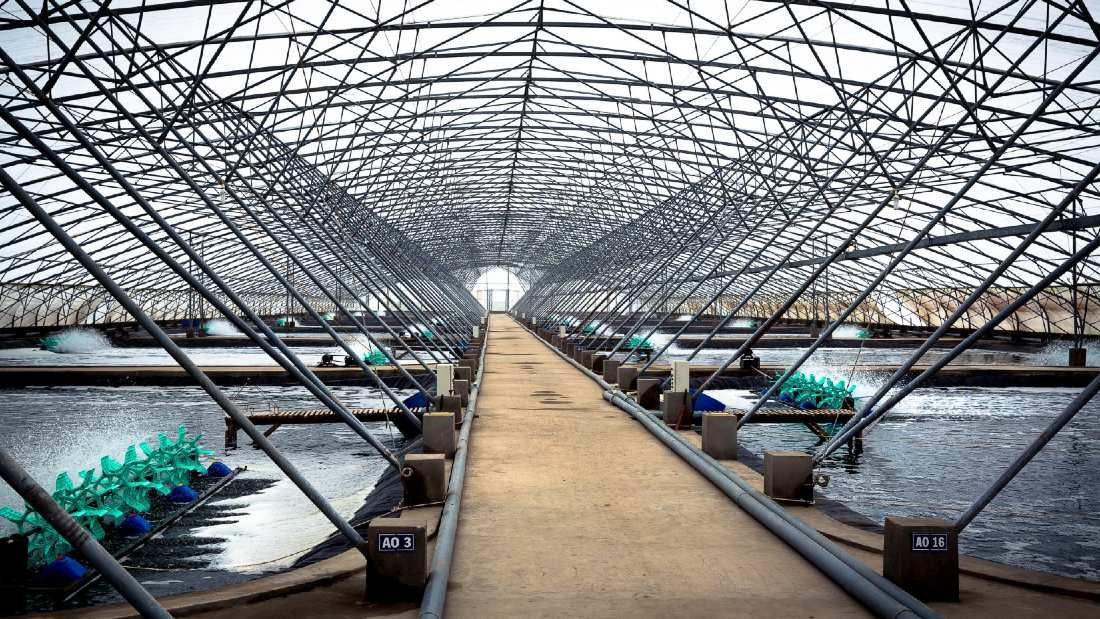
Farmers have experimented with caging prawns and shrimp in these growout farms, which consists of floating structures typically enclosed in netting, as well as pens, whereby parts of a lake or reservoir are separated by nets. This method has largely been abandoned in favour of concrete, shallow ponds which are more productive and profitable.25FAO, 2002. ‘Farming freshwater prawns.’ Food and Agriculture Organisation of the United Nations. Available at http://www.fao.org/3/y4100e/y4100e08.htm#P1354_219801 [Accessed 19 January 2021].
As you can see in the following photos, these ponds and pens are barren environments which are completely removed from a natural environment for prawns or shrimp. Far from the thriving environments of mangrove forests where prawns and shrimp naturally would grow, aquaculture means concrete, crowded rectangles where the prawns or shrimp will be kept
for five months until they are killed. Over the course of one batch of prawns or shrimp, the floor will be covered in rotting food pellets and prawn and shrimp waste before that water is flushed out into nearby rivers and the ocean and the process is started all over again.
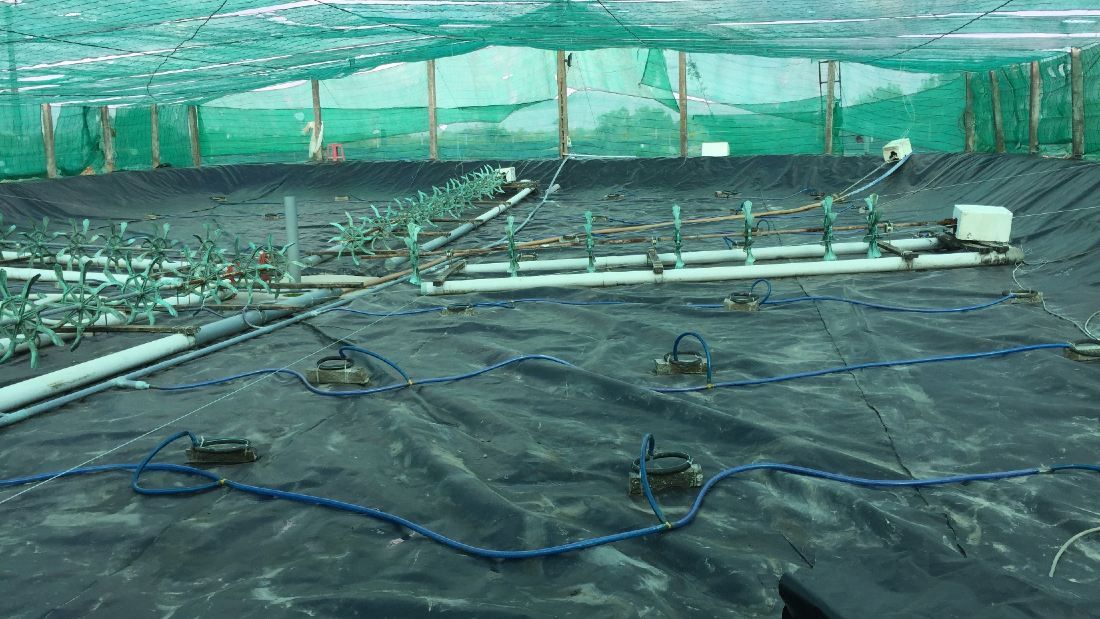
Semi-Intensive and Extensive Farming
Extensive prawn or shrimp farming means that the farmer holds a small-scale farm, ranging from three to five hectares.57Seafood TIP. ‘Improved extensive shrimp farming.’ Available at https://seafood-tip.com/sourcing-intelligence/countries/vietnam/shrimp/extensive/ [Accessed 20 January 2021]. These farms often farm multiple species, such as crabs, while primarily focussing on Black Tiger shrimp (Seafood TIP). They usually harvest 300-450 kilograms of prawns per hectare. Extensive farming has the lowest number of prawns per square metre compared to semi-intensive and intensive farming at approximately two prawns per square metre.27Seafood TIP. ‘Improved extensive shrimp farming.’ Available at https://seafood-tip.com/sourcing-intelligence/countries/vietnam/shrimp/extensive/ [Accessed 20 January 2021]. These types of farms usually use a natural tide to restock water, bring in feed for the prawns or shrimp as well as capturing wild seeds to be used as the new stock, though they do also use commercial feed when tides don’t bring in sufficient quantities of feed.27Seafood TIP. ‘Improved extensive shrimp farming.’ Available at https://seafood-tip.com/sourcing-intelligence/countries/vietnam/shrimp/extensive/ [Accessed 20 January 2021]. Extensive farming is seasonal based on the natural reproduction of prawns and shrimp.27Seafood TIP. ‘Improved extensive shrimp farming.’ Available at https://seafood-tip.com/sourcing-intelligence/countries/vietnam/shrimp/extensive/ [Accessed 20 January 2021].
There is little to no regulation on small-scale prawn and shrimp farms and as they rely on incoming tides they are directly linked to mangrove deforestation by encroaching more and more on areas next to tidal waters. The ponds are made of concrete and offer barren environments.
Semi-intensive farms solely farm prawns or shrimp, have higher stocker rates than extensive farming at 20 to 50 prawns or shrimp per square metre and use both tidal waters as a way of getting feed as well as commercial feed.58Seafood TIP. ‘Semi-intensive shrimp farming.’ Available at https://seafood-tip.com/sourcing-intelligence/countries/philippines/cultured-shrimp/semi-intensive/ [Accessed 20 January 2021]. Like intensive farming, semi-intensive farms tend to force captive prawns or shrimp to reproduce new batches rather than rely on wild seedlings floating into their farms.
Reproduction
In extensive farming, wild seeds floating in brackish water such as in mangrove forests are trapped and transferred into these hatcheries to use as stock for farmers.59FAO, 2021. ‘Penaeus monodon.’ Food and Agriculture Organisation of the United Nations. Available at http://www.fao.org/fishery/culturedspecies/Penaeus_monodon/en [Accessed 19 January 2021]. But another, far more grotesque way of forcing captured prawns and shrimp to produce larvae was developed in the 1970s and has quickly become the standard way of collecting larvae.29FAO, 2021. ‘Penaeus monodon.’ Food and Agriculture Organisation of the United Nations. Available at http://www.fao.org/fishery/culturedspecies/Penaeus_monodon/en [Accessed 19 January 2021]. Farmed conditions are so far removed from a prawn or shrimp’s natural habitat that their ovaries respond by inhibiting them from reproducing, and so in order to create hatcheries a hideous mutilation has become the standard way of forcing these animals to produce larvae for nurseries. It is known as eyestalk ablation.29FAO, 2021. ‘Penaeus monodon.’ Food and Agriculture Organisation of the United Nations. Available at http://www.fao.org/fishery/culturedspecies/Penaeus_monodon/en [Accessed 19 January 2021].
Eyestalk Ablation Mutilation
In almost every semi-intensive and intensive marine prawn and shrimp farm across the world the females suffer the grotesque practice of ‘eyestalk ablation’.60Liu, J., Zhou, T., Wang, C., Wang, W., Chan, S., 2020. ‘Comparative transcriptomics reveals eyestalk ablation induced responses of the neuroendocrine-immune system in the Pacific white shrimp Litopenaeus vannamei.’ Fish & Shellfish Immunology, 21 August. Available at https://www.sciencedirect.com/science/article/abs/pii/S1050464820305933 [Accessed 7 September 2020]. Rather than improve conditions to increase reproduction numbers, instead their eyes are mutilated, a practice which breaks down the inhibitory hormones that these animals use to determine breeding and non-breeding season.30Liu, J., Zhou, T., Wang, C., Wang, W., Chan, S., 2020. ‘Comparative transcriptomics reveals eyestalk ablation induced responses of the neuroendocrine-immune system in the Pacific white shrimp Litopenaeus vannamei.’ Fish & Shellfish Immunology, 21 August. Available at https://www.sciencedirect.com/science/article/abs/pii/S1050464820305933 [Accessed 7 September 2020]. The mutilation forces them to reproduce, and those seeds are transferred into nurseries.30Liu, J., Zhou, T., Wang, C., Wang, W., Chan, S., 2020. ‘Comparative transcriptomics reveals eyestalk ablation induced responses of the neuroendocrine-immune system in the Pacific white shrimp Litopenaeus vannamei.’ Fish & Shellfish Immunology, 21 August. Available at https://www.sciencedirect.com/science/article/abs/pii/S1050464820305933 [Accessed 7 September 2020].
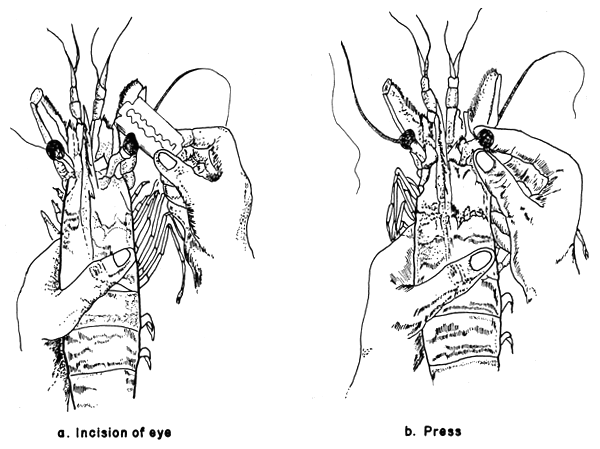
Guide to eyestalk ablution from the Food and Agriculture Organisation’s prawn and shrimp manual.
This mutilation is done by slicing open one or both of the female’s eyes with a razor blade, by tying off the eyestalk with a tight thread, using a red-hot wire or by pinching the eyestalk, leaving an open wound. Prawns and shrimp who suffer from this eye-removal are disoriented, constantly rub the traumatised area, and flick their tail repeatedly, which is an escape reflex.6Diarte-Plata, G., Sainz-Hernandez, J., Aguinage-Cruz, J., Fierro-Coronado, J., Polanco-Torres, A., Puente-Palazeulos, C., 2012. ‘Eyestalk ablation procedures to minimize pain in the freshwater prawn Macrobrachium americanum.’ Applied Animal Behaviour Science, September. Vol. 140. Available at https://www.sciencedirect.com/science/article/abs/pii/S0168159112001761 [Accessed 7 September 2020]. These three actions are all consistent with behaviours that respond to pain in other animals and they must suffer immensely. It also takes away the ability to see, either partially or completely if both eyes are destroyed. Given that these animals are kept in crammed conditions, it only adds to the stress and disorientation. They are treated as nothing more than breeding machines for ‘nurseries’ with no regard for their wellbeing.
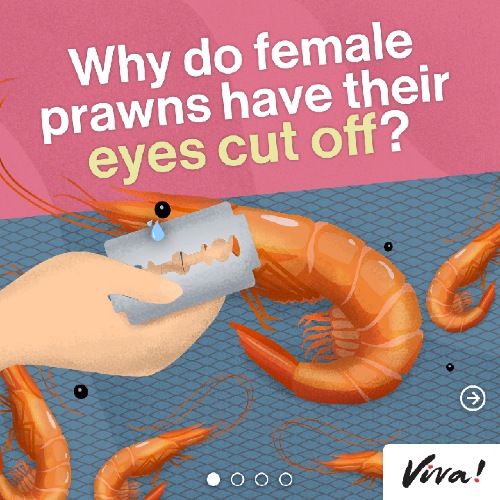
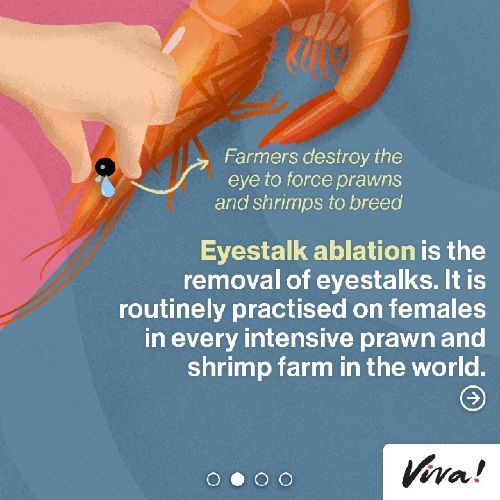
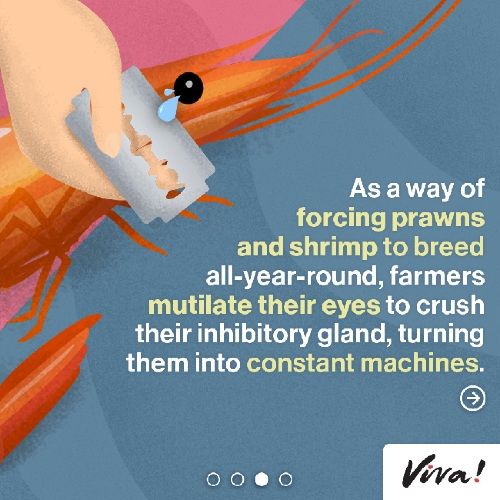
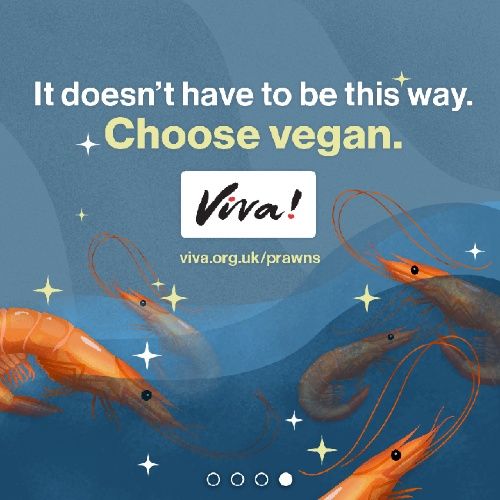
Disease
The industry is ravaged by diseases and bacterial diseases pose the most serious challenge.14Bermudez-Almada, M.C.., Espinosa-Plascencia, A., 2012. ‘The Use of Antibiotics in Shrimp Farming.’ Research Center for Food and Development, April. Available at https://cdn.intechopen.com/pdfs/35142/…of_antibiotics_in_shrimp_farming.pdf [Accessed 8 September 2020]. The industry’s standard way of dealing with any diseases is by pumping antibiotics into the ponds, even when the prawns and shrimp are just larval.14Bermudez-Almada, M.C.., Espinosa-Plascencia, A., 2012. ‘The Use of Antibiotics in Shrimp Farming.’ Research Center for Food and Development, April. Available at https://cdn.intechopen.com/pdfs/35142/…of_antibiotics_in_shrimp_farming.pdf [Accessed 8 September 2020]. Disease easily spreads in these farms and after just a handful of years productivity quickly declines as waters become increasingly contaminated.
Necrotizing hepatopancreatitis (NHP) and diseases caused by the bacteria of the Vibrio genus are the most significant of all diseases in prawn and shrimp farms.14Bermudez-Almada, M.C.., Espinosa-Plascencia, A., 2012. ‘The Use of Antibiotics in Shrimp Farming.’ Research Center for Food and Development, April. Available at https://cdn.intechopen.com/pdfs/35142/…of_antibiotics_in_shrimp_farming.pdf [Accessed 8 September 2020]. Infected prawns and shrimp suffer from lethargy, weak bodies, and a darkened appearance and it kills up to 95 per cent of all organisms in the fisheries.14Bermudez-Almada, M.C.., Espinosa-Plascencia, A., 2012. ‘The Use of Antibiotics in Shrimp Farming.’ Research Center for Food and Development, April. Available at https://cdn.intechopen.com/pdfs/35142/…of_antibiotics_in_shrimp_farming.pdf [Accessed 8 September 2020].
Prawns and shrimp affected by the Vibrio genus suffer from bacterial erosion of their shells, small balls forming on their bodies and it has high mortality rates.14Bermudez-Almada, M.C.., Espinosa-Plascencia, A., 2012. ‘The Use of Antibiotics in Shrimp Farming.’ Research Center for Food and Development, April. Available at https://cdn.intechopen.com/pdfs/35142/…of_antibiotics_in_shrimp_farming.pdf [Accessed 8 September 2020]. Yellowhead disease spread throughout South-East Asia in the 1990s, is highly contagious and kills most of the infected population within four days – it can wipe out entire populations. Early mortality syndrome also decimates entire populations.
Australia’s prawn industry was ravaged in 2017 by white spot disease, a highly contagious infection which is lethal to crustaceans. The disease spread its way through fisheries and has now infected wildlife in the oceans. In the Queensland Government’s words, the virus ‘now cannot be stopped’.62ABC News, 2017. ‘“Unstoppable” white spot virus detected in Moreton Bay’s wild prawns.’ ABC News, 16 March. Available at https://www.abc.net.au/news/2017-03-16/white-spot-virus-spreads-into-wild-prawns-moreton-bay-brisbane/8359212 [Accessed 8 September 2020]. Our mismanagement of farmed prawns and shrimp undoubtedly inflicts suffering on those creatures, but it also poses a serious risk of devastating ocean ecosystems.
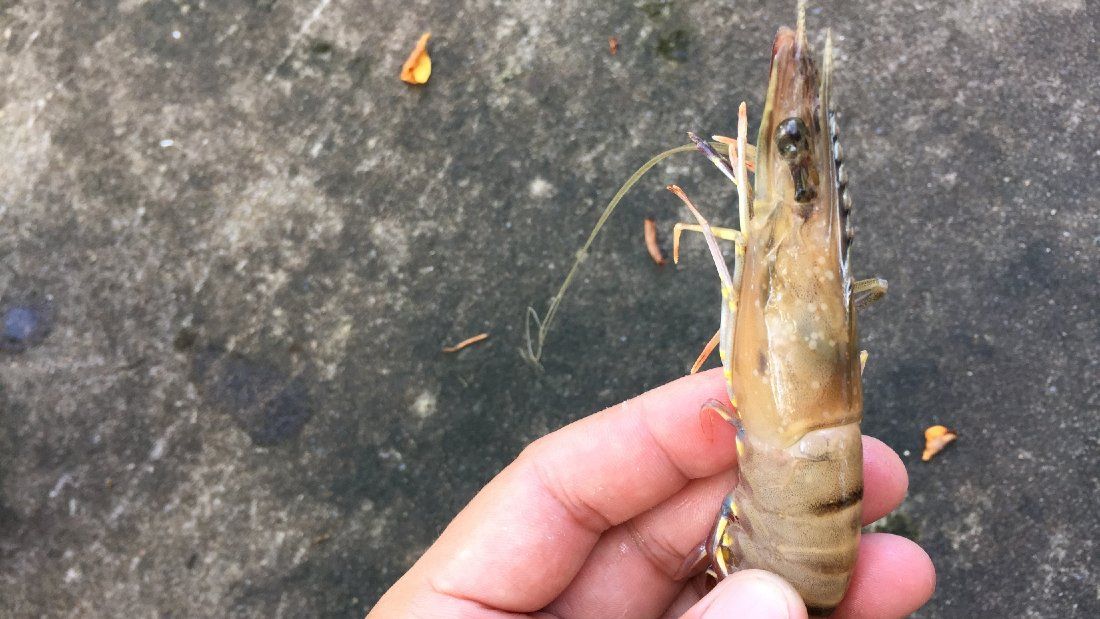
The Australian Government responded to the white spot disease by suffocating millions of prawns to death with lethal chlorine pumped into the ponds.65Atkin, M., 2017. ‘Prawn industry ravaged by white spot disease.’ ABC, 18 January. Available at https://www.abc.net.au/7.30/prawn-industry-ravaged-by-white-spot-disease/8190282 [Accessed 7 September 2020]. As the chlorine seeped into the water, prawns were seen jumping out, choking and desperately trying to find oxygen but were left to suffocate in agony as the chlorine filled their gills. The very same disease ravaged industries across Asia in the 1990s and will undoubtedly strike again, causing the unjustifiable deaths of millions of animals because of producers’ mismanagement.
The common denominator in all of these infections is the extreme stress placed on the animal as a result of high stocking densities and unhygienic water, as well as the extremely unnatural conditions in which they are forced to live.14Bermudez-Almada, M.C.., Espinosa-Plascencia, A., 2012. ‘The Use of Antibiotics in Shrimp Farming.’ Research Center for Food and Development, April. Available at https://cdn.intechopen.com/pdfs/35142/…of_antibiotics_in_shrimp_farming.pdf [Accessed 8 September 2020].
The aquaculture industry’s way of ‘managing’ these diseases is to kill off the entire populations and start again as it’s cheaper than any treatment.14Bermudez-Almada, M.C.., Espinosa-Plascencia, A., 2012. ‘The Use of Antibiotics in Shrimp Farming.’ Research Center for Food and Development, April. Available at https://cdn.intechopen.com/pdfs/35142/…of_antibiotics_in_shrimp_farming.pdf [Accessed 8 September 2020]. With the replacement batch, antibiotics are liberally used in the hope that this will stave off future diseases but if history is anything to go by, it doesn’t work and diseases will continue to decimate populations. The industry’s irresponsible overuse of antibiotics poses a serious risk of antibiotic resistance not just in marine life but also in humans.
Antibiotics
Prawn and shrimp farming is unregulated and most of the product is exported from countries such as India or Thailand. As a result, the majority of prawns and shrimp eaten in the UK have been fed on antibiotics in an attempt to keep disease at bay in the filthy, faeces-laden ponds.
The more antibiotics are used in intensive animal farming, the higher the risk to humans from antibiotic-resistant bacteria – superbugs. It’s already happening and people are dying because for some diseases, there are no antibiotics left with which to treat them.66World Health Organization, 2017. ‘Antimicrobial resistance in the food chain.’ WHO, November. Available at https://www.who.int/foodsafety/areas_work/antimicrobial-resistance/amrfoodchain/en/ [Accessed 9 September 2020].
The World Health Organisation has for a long time been urging us to reduce the use of antibiotics in farmed animals to preserve their effectiveness for human use. We, as consumers, must stop supporting intensive industries such as prawn and shrimp aquaculture as well as meat, dairy and eggs.33World Health Organization, 2017. ‘Antimicrobial resistance in the food chain.’ WHO, November. Available at https://www.who.int/foodsafety/areas_work/antimicrobial-resistance/amrfoodchain/en/ [Accessed 9 September 2020].
Trawling for Feed Used in Aquaculture
Bottom trawling is used for wild-capture prawns and shrimp, but it is also used to capture marine animals to be ground up and used as feed in aquaculture. The nets and the heavy trawl boards that keep the mouth of the net open destroy the seabed’s ecology, including coral reefs, and they scoop up everything in their path – octopi, turtles, dolphins, sea snakes, puffer fish, crabs and a whole host of marine wildlife. The nets are pulled to the surface where all of the animals are killed, often by bludgeoning them to death or leaving them to asphyxiate. They are then thrown into the ‘trash fish’ hold where they are left to rot for weeks.68Wickens, J., 2013. ‘Love eating prawns? You’ll go right off them after we tell you what THEY are fed on.’ Daily Mail, March. Available at https://www.dailymail.co.uk/health/article-2294246/Love-eating-prawns-Youll-right-tell-THEY-fed-on.html [Accessed 19 January 2021]. When the ship returns to land, the rotting flesh is ground up, turned into pellets and used as feed for farmed prawns.
It takes more than twice the weight of animal flesh fed to the prawns to produce the same weight in prawn flesh, meaning that for every kilogram of prawns you buy, at least two kilograms of marine life has been killed.70Lawrence, F., 2003. ‘Is it OK to eat tiger prawns?’ The Guardian, 19 June. Available at https://www.theguardian.com/news/2003/jun/19/food.fishing [Accessed 8 September 2020]. This excludes the number of animals killed from bycatch, meaning the number of animals killed per prawn is even higher.
Mangrove Forests
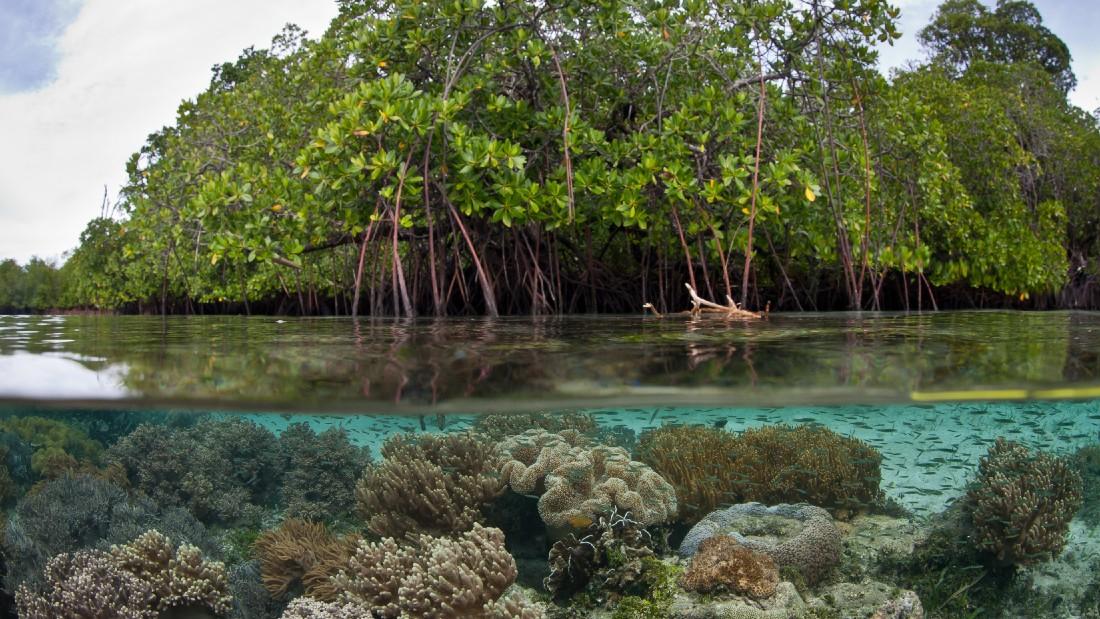
Mangrove forests – a natural defence against flooding and coastal erosion for Thailand and much of the world and a crucial ecosystem – have been destroyed and replaced by mile after mile of prawn and shrimp farms.34Wickens, J., 2013. ‘Love eating prawns? You’ll go right off them after we tell you what THEY are fed on.’ Daily Mail, March. Available at https://www.dailymail.co.uk/health/article-2294246/Love-eating-prawns-Youll-right-tell-THEY-fed-on.html [Accessed 19 January 2021]. The demand for increased production comes from the UK, Europe and North America and has ravaged swathes of vital ecosystems and indigenous communities in the pursuit of big profits.34Wickens, J., 2013. ‘Love eating prawns? You’ll go right off them after we tell you what THEY are fed on.’ Daily Mail, March. Available at https://www.dailymail.co.uk/health/article-2294246/Love-eating-prawns-Youll-right-tell-THEY-fed-on.html [Accessed 19 January 2021]. It’s estimated that one quarter of mangrove destruction is directly linked to prawn and shrimp farming.74Hamilton, S., 2013. ‘Assessing the role of commercial aquaculture in displacing mangrove forest.’ University of Miami, April. Available at https://www.ingentaconnect.com/content/umrsmas/bullmar/2013/00000089/00000002/art00013;jsessionid=3c3e1kescfwcr.x-ic-live-03# [Accessed 19 January 2021].
Mangrove forests have coastal salty or brackish water, an ecosystem where prawns and many other species naturally thrive. They are known as ‘major nursery grounds’, meaning that they are ideal breeding grounds for a huge diversity of marine animals and are of vital importance for much of the world’s fish, prawns, crabs and other wildlife. It’s estimated that three in every four fish who are commercially caught spend some time in the mangroves or are reliant on them through food webs that depend on mangroves and mangroves provide homes for up to 174 marine species of megafauna.75American Museum of Natural History. ‘Why Mangroves Matter.’ AMNH. Available at https://www.amnh.org/explore/videos/biodiversity/mangroves-the-roots-of-the-sea/why-mangroves-matter [Accessed 19 January 2021].76Sievers, M., Brown, C., Tulloch, V., Haig, J., Turschwell, M., Connolly, R., 2019. ‘The Role of Vegetated Coastal Westlands for Marine Megafauna Conservation.’ Trends in Ecology & Evolution, May. Available at https://www.cell.com/trends/ecology-evolution/fulltext/S0169-5347(19)30109-0 [Accessed 19 January 2021].
In other words, the destruction of mangroves for prawn and shrimp farms directly threatens the vast majority of our oceans’ biodiversity not only in the local areas affected but across the world while also ripping up natural coastal defences for countries such as Thailand. Mangroves are also extremely efficient at storing carbon, more so than other forests, and it is only in recent years that people have started to realise the crucial importance of trying to protect these forests before they’re all gone.
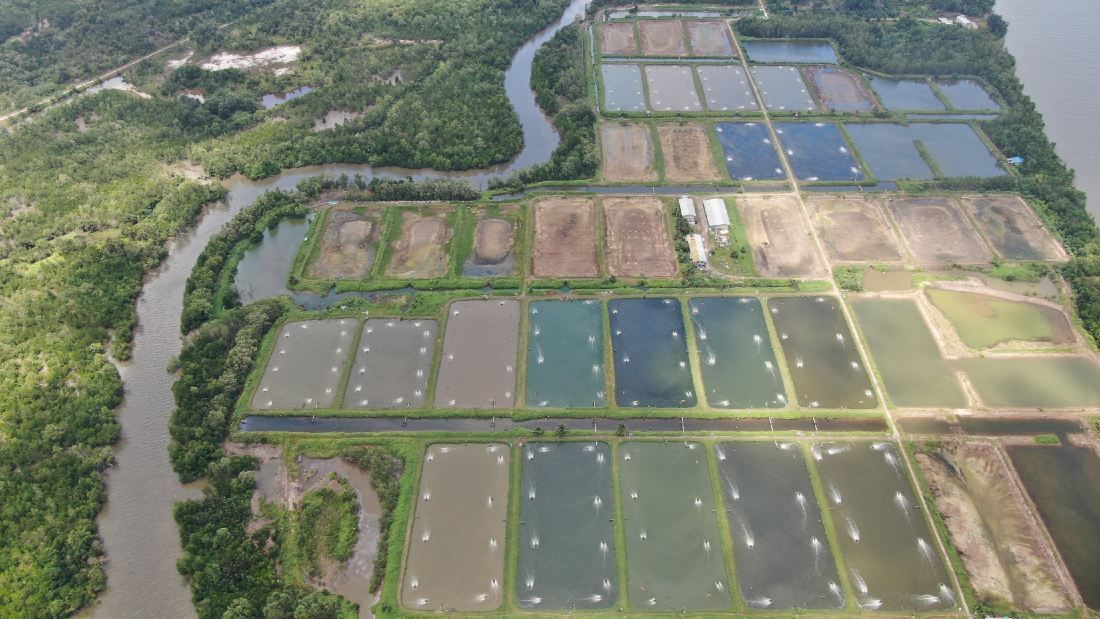
Once an area of land has been used as a prawn or shrimp fishery it is near impossible to use it for anything and even nature is unable to take over again. Huge numbers of these fisheries are abandoned as soon as production slumps, leaving behind salt-ridden land where nothing can grow.35Lawrence, F., 2003. ‘Is it OK to eat tiger prawns?’ The Guardian, 19 June. Available at https://www.theguardian.com/news/2003/jun/19/food.fishing [Accessed 8 September 2020]. To make matters worse, farmers often drain the entire pond or lagoon as an easy way of collecting all the animals left behind, meaning that wastewater from the ponds – water which has been filled with excreta and rotting food for months – is frequently flooded out into what remains of the mangrove forests or into the sea to cause further harm.34Wickens, J., 2013. ‘Love eating prawns? You’ll go right off them after we tell you what THEY are fed on.’ Daily Mail, March. Available at https://www.dailymail.co.uk/health/article-2294246/Love-eating-prawns-Youll-right-tell-THEY-fed-on.html [Accessed 19 January 2021].
The Human Cost
After a six-month investigation in 2014 and again in 2018, UK supermarkets were exposed for selling prawns and shrimp originating from farms built on modern-day slavery.79Hodal, K., Kelly, C., Lawrence, L., 2014. ‘Revealed: Asian slave labour producing prawns for supermarkets in US, UK.’ The Guardian, 10 June. Available at https://www.theguardian.com/global-development/2014/jun/10/supermarket-prawns-thailand-produced-slave-labour [Accessed 8 September 2020].80Kelly, A., 2018. ‘Thai seafood: are the prawns on your plate still fished by slaves?’ The Guardian, 23 January. Available at https://www.theguardian.com/global-development/2018/jan/23/thai-seafood-industry-report-trafficking-rights-abuses [Accessed 8 September 2020]. People, often immigrants desperate for jobs, are tricked into becoming workers on trawlers by being promised fair wages when the truth is, because of their vulnerable status and become modern-day slaves. They often are forced to work 20-hour shifts, are beaten, tortured and even killed in the pursuit of ‘trash fish’ to use as feed in prawn and shrimp aquaculture (Kelly, 2018). Similar conditions and abuse apply to the large numbers of workers who process the animals ashore in large sheds.
Salination and pollution from chemicals used in prawn and shrimp farming have contaminated drinking water in local communities. There is often no regulation on how to discard wastewater from fisheries, which is emptied into rivers, canals and coastal waters which become polluted with pesticides, antibiotics and disinfectants. In Sri Lanka, almost three quarters of fishermen in prawn and shrimp farming areas do not have easy access to drinking water any more thanks to the industry.35Lawrence, F., 2003. ‘Is it OK to eat tiger prawns?’ The Guardian, 19 June. Available at https://www.theguardian.com/news/2003/jun/19/food.fishing [Accessed 8 September 2020]. Thousands of Bangladeshi farmers have experienced violence and intimidation from farm owners who destroy their rice paddies to make way for even more farms.35Lawrence, F., 2003. ‘Is it OK to eat tiger prawns?’ The Guardian, 19 June. Available at https://www.theguardian.com/news/2003/jun/19/food.fishing [Accessed 8 September 2020].
Aquaculture in the UK
At present there is very little prawn or shrimp aquaculture in the UK with only two commercial farms in the nation forming a negligible percentage of consumption. One of these hopes to produce 50 tonnes of prawns per year, while the UK currently consumes 40,000 tonnes every year (Fletcher, 2019; Pegg, 2019).19Fletcher, R., 2019. ‘Britain’s prawn farming pioneers.’ The Fish Site, June. Available at https://thefishsite.com/articles/britains-prawn-farming-pioneers [Accessed 19 January 2021].17Pegg, S., 2019. ‘Market Insight Factsheet: Prawn and Shrimp.’ Seafish, March. Available at https://www.seafish.org/document/?id=14501ed6-60d1-4d6e-b630-da2d96c50908 [Accessed 7 September 2020].
These two farms advertise themselves as ‘responsibly’ or ‘sustainably’ sourced as they are not transported from far-off countries like Thailand or India, and they are looking to attract consumers who are increasingly concerned about buying sustainable food.
However, prawns and shrimp are carnivorous, and they often need to be fed twice their retail weight, meaning that, as with all animal products, it’s always going to be a far more efficient use of resources to go directly to plants.35Lawrence, F., 2003. ‘Is it OK to eat tiger prawns?’ The Guardian, 19 June. Available at https://www.theguardian.com/news/2003/jun/19/food.fishing [Accessed 8 September 2020]. These farms are indoors and there is not even a pretence of creating a natural environment for the prawns who are kept in barren ponds inside. And while these UK prawn farms might like to advertise themselves as ethical, there’s no getting around the fact that they are killing millions of prawns every year.
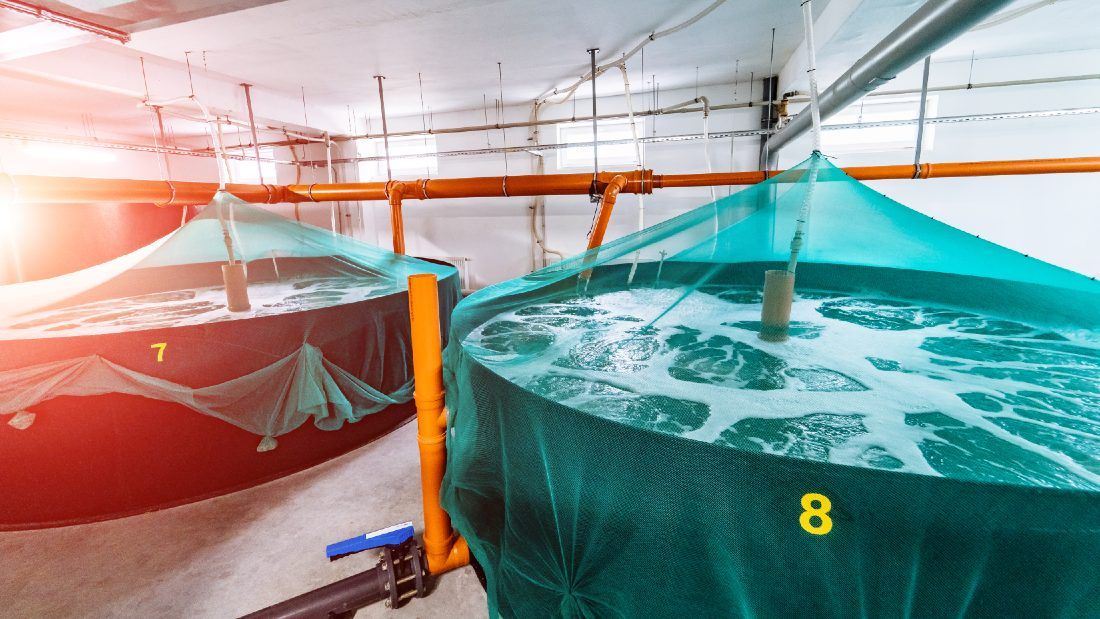
In aquaculture, prawns and shrimp are usually left without food for at least 24 hours before being killed to make their bodies more appealing to consumers. They have an intestinal tract, also known as the ‘back vein’, which is filled with blackened food that they are digesting. Through starvation, these visible excreta are passed out of the body and nothing replaces it. In wild-caught fisheries, the black vein is sometimes cut out of the animals after they have been boiled in commercial plants.
When prawns and shrimp reach a marketable weight, they are usually removed from the ponds by seining – a method of fishing which uses a fishing net known as a seine that is dragged through the water and pulls the animals to the surface.25FAO, 2002. ‘Farming freshwater prawns.’ Food and Agriculture Organisation of the United Nations. Available at http://www.fao.org/3/y4100e/y4100e08.htm#P1354_219801 [Accessed 19 January 2021]. The other common method is to drain the pond and workers will then collect the prawns and shrimp in nets (FAO, 2002). They are then bagged up in their thousands, which causes suffocation and many deaths. There is no record of the quantity as there is no legislation governing their welfare or killing. Mortality is likely to be high.
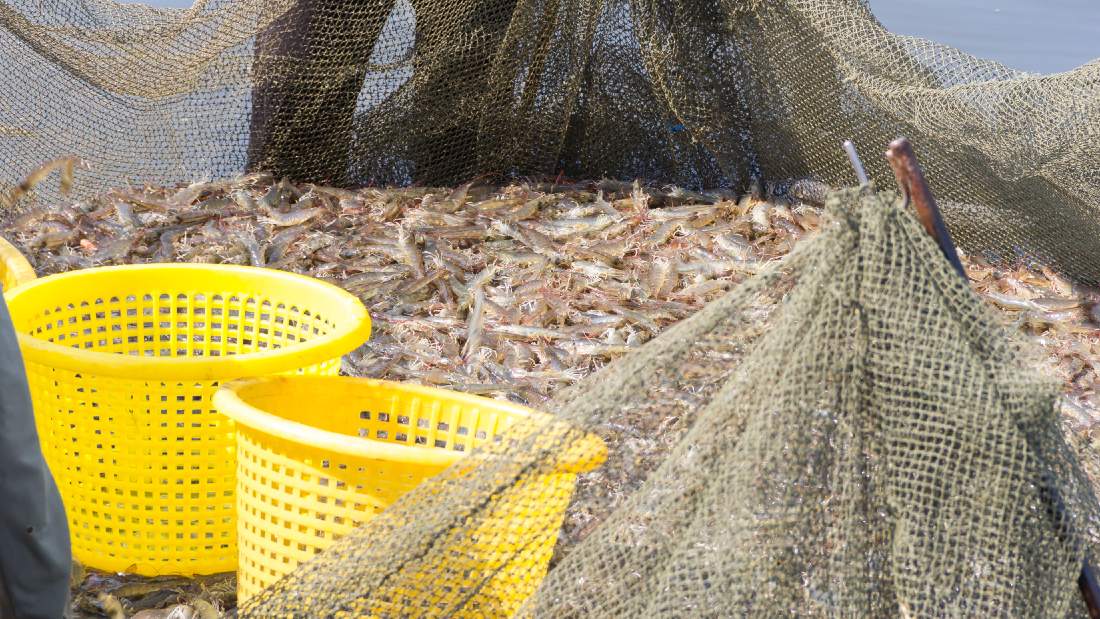
The animals are usually then tumbled into chilled boxes to keep them fresh and alive. There is a market for live prawns and shrimp, which only prolongs their suffering. They will be kept in tanks, crammed together and transported for hours to live markets. Mortality is high at about 10 per cent, largely through fighting and cannibalism caused by the high-stress conditions (Tidwell, Coyle, 2011). When they reach markets, they are usually kept on ice and left to die by asphyxiation or by freezing, or to be killed by consumers in their own kitchens however they choose. Like other crustaceans such as lobsters or crabs, there is no regulation on how to kill prawns or shrimp.
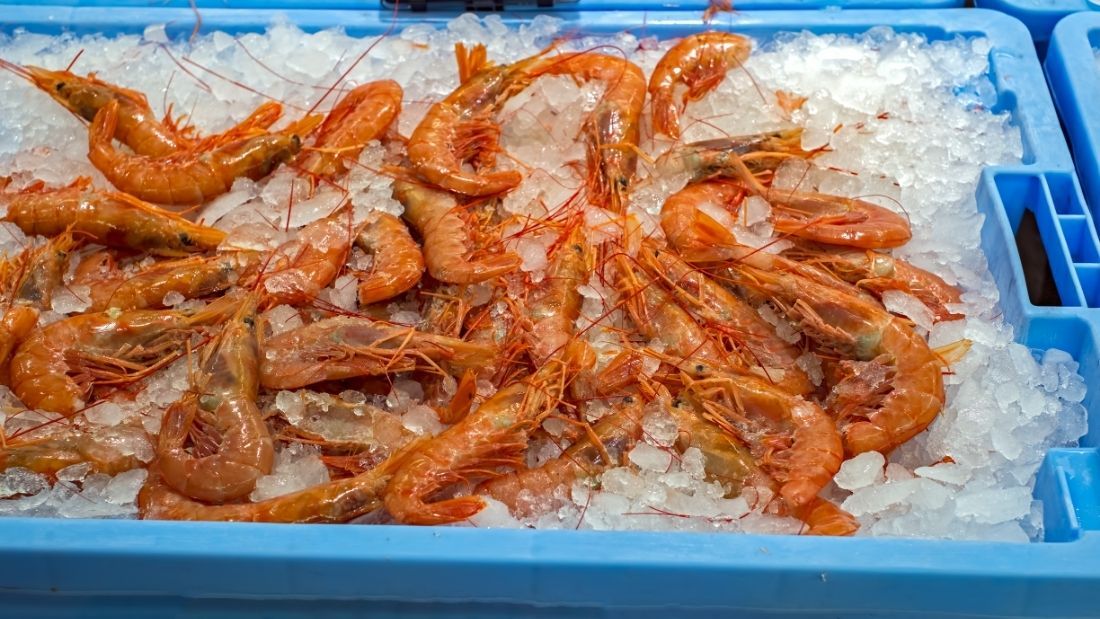
A recommended way of killing prawns is to place them in ‘chill-kill tanks’, full of ice and water.82Tidwell, J., Coyle, S., 2011. ‘Post-Harvest Handling of Freshwater Prawns.’ Southern Regional Aquaculture Center, May. Available at https://freshwater-aquaculture.extension.org/wp-content/uploads/2019/08/Post-harvest_handling_of_freshwater_prawns.pdf [Accessed 8 September 2020]. It’s recommended to keep them in there for 20 minutes, at which point they are rendered insensible.41Tidwell, J., Coyle, S., 2011. ‘Post-Harvest Handling of Freshwater Prawns.’ Southern Regional Aquaculture Center, May. Available at https://freshwater-aquaculture.extension.org/wp-content/uploads/2019/08/Post-harvest_handling_of_freshwater_prawns.pdf [Accessed 8 September 2020]. Workers then cut through the centreline of the head and tail. It’s claimed they don’t suffer at the point of killing but they have already experienced long periods of stress and suffering up to this point, let alone the needless taking of their life.
Although this is the recommended slaughter method, there’s no guarantee that those sold in UK have been killed in that way. Some will have been frozen to death and others suffocated or cut into while fully conscious in this unregulated industry. Many people who buy prawns and shrimp have no idea of the animal welfare, human and environmental costs involved.

